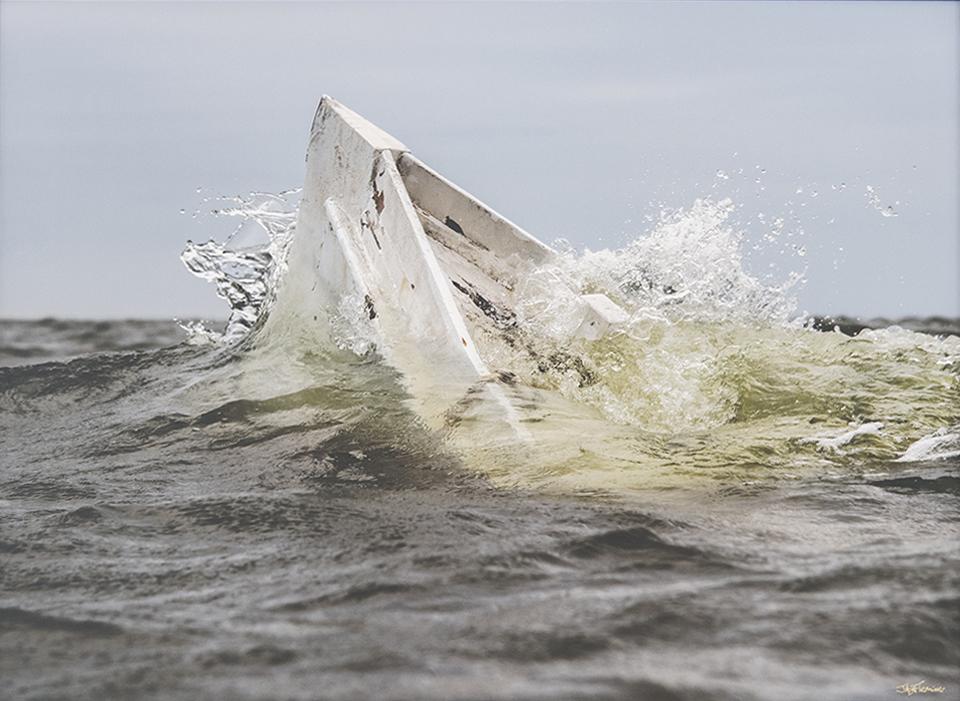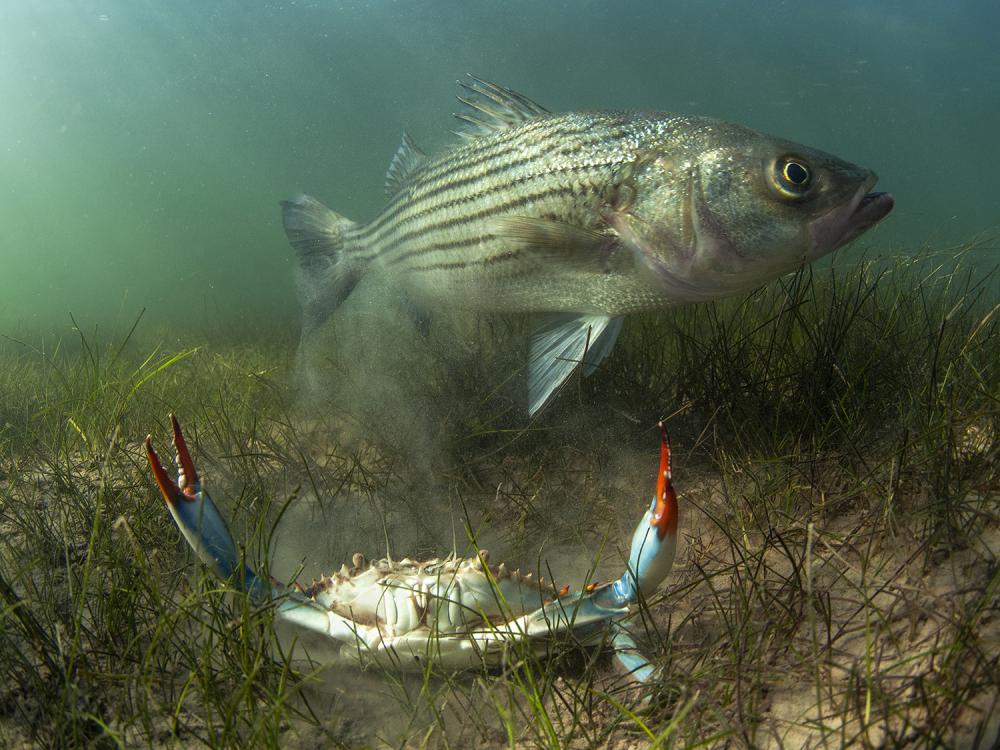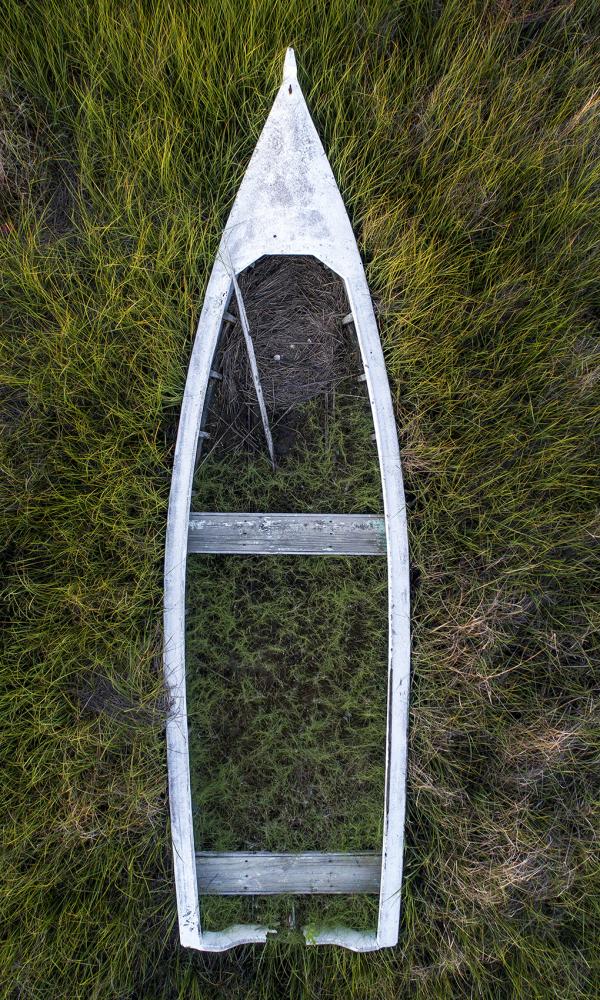While the Academy Art Museum continues to celebrate its 60th anniversary with its downstairs galleries filled with a wide-ranging and fascinating exhibit of works drawn from its permanent collection, upstairs is a remarkable little show by Annapolis photographer Jay Fleming.
Inventive and spectacular are two good words for describing Fleming’s photographs. There’s only the tip of the bow of a boat showing in his photo, “Sinking Workboat,” as it is engulfed by the waves. It’s such a startling image that it’s hard to imagine how he ever managed to shoot it. Its splashing water is so clear and fresh and the deep water surrounding the boat is so dark and foreboding that it’s like a dream, or in the context of this show, a nightmare.
Fleming’s exhibit, “Island Life,” on view through November 11, documents life on the Chesapeake’s only inhabited offshore islands, Smith Island and Tangier Island. Preserving traditions dating back to the islands’ settlement in the late 1600s, many of the islanders still make their living from the Bay’s waters, but rising sea levels, subsiding land and environmental stresses on the Bay and the species it supports threaten both their homes and their livelihoods.

Jay Fleming, “Sinking Workboat,” archival matte canvas print
The mingling of exquisite beauty and a sense of wrenching loss so apparent in “Sinking Workboat” is repeated throughout this show. The shimmering warmth of low sunlight on a venerable workboat is made poignant by its name, spelled out in peeling paint along its bow, “Last Call,” while across the gallery is “Abandoned House on Smith Island,” a shot of a weathered and broken-windowed home standing bravely amidst scraggly bushes and weeds.
The son of a National Geographic photographer, Fleming has his father’s skill at documentation, and he uses his talents and deep knowledge of the Chesapeake region both to earn a living as a commercial photographer and to pursue his passion for documentary art. His photographs are often seen on the covers of such magazines as Wooden Boat and the Chesapeake Bay Foundation’s Save the Bay, and he recently published a stunning book of photographs called Working the Water that chronicles the lives of the Bay’s watermen.
 What sets Fleming’s work apart is not just his skill and his easy familiarity with human interactions with the Bay and its creatures, but perhaps most importantly, his dazzling ability to make change visible. Heart-wrenching photos of abandoned houses have become ubiquitous in articles about rising sea levels, but Fleming captured his standing in eerie stillness while a flight of blackbirds swoops away under a lowering sky. A riveting glimpse of the last moment before the birds disappear and the fury of the storm begins, it’s a potent metaphor for the plight of these sinking islands and the loss of a way of life.
What sets Fleming’s work apart is not just his skill and his easy familiarity with human interactions with the Bay and its creatures, but perhaps most importantly, his dazzling ability to make change visible. Heart-wrenching photos of abandoned houses have become ubiquitous in articles about rising sea levels, but Fleming captured his standing in eerie stillness while a flight of blackbirds swoops away under a lowering sky. A riveting glimpse of the last moment before the birds disappear and the fury of the storm begins, it’s a potent metaphor for the plight of these sinking islands and the loss of a way of life.

Jay Fleming, “Abandoned Skiff,” archival matte canvas print
It’s a puzzle how Fleming manages to create many of these photographs. Somehow, he’s in the right place at the right time, focused and ready to shoot. “Rockfish and Blue Crab” captures these iconic denizens of the Bay together in an underwater double portrait so crisp and colorful that, again, it seems as if it’s out of a dream. Likewise, “Above the Buyboat Delvin K” catches a graceful dance of oyster boats seen from above as they shimmy up to a buy boat to transfer their daily catch. It’s pure beauty, and it’s all about fleeting moments and changing times, laced through with the inkling that what we’re seeing will never be the same.
There’s magic in these photographs, and though we long for preservation and stability, it’s intoxicating to see one scene after another teetering on the edge of change. Still, Fleming conjures a certain optimism in the beauty and clarity of his photographs and in his ability to see familiar things anew. With its bow bearing a curious resemblance to the pointed arch of a shrine, a skiff left to decay in the marsh is a forlorn sight at first glance, but inside is a sign of renewal and hope in the form of a bird’s nest complete with eggs. Change is inevitable whether through human effort or by nature reclaiming its own, but these photographs suggest that by paying attention, there may still be ways to instigate positive changes for the Bay and those of us who live and visit here.
Mary McCoy is an artist and writer who has the good fortune to live beside an old steamboat wharf on the Chester River. She is a former art critic for the Washington Post and several art publications. She enjoys the kayaking the river and walking her family farm where she collects ideas and materials for the environmental art she creates, often in collaboration with her husband Howard. They have exhibited their work in the U.S., Ireland, Wales and New Zealand.




Write a Letter to the Editor on this Article
We encourage readers to offer their point of view on this article by submitting the following form. Editing is sometimes necessary and is done at the discretion of the editorial staff.